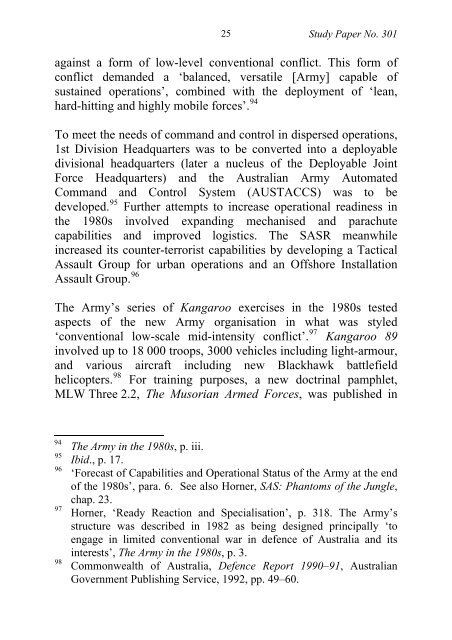Ibid - Australian Army
Ibid - Australian Army
Ibid - Australian Army
Create successful ePaper yourself
Turn your PDF publications into a flip-book with our unique Google optimized e-Paper software.
25<br />
Study Paper No. 301<br />
against a form of low-level conventional conflict. This form of<br />
conflict demanded a ‘balanced, versatile [<strong>Army</strong>] capable of<br />
sustained operations’, combined with the deployment of ‘lean,<br />
hard-hitting and highly mobile forces’. 94<br />
To meet the needs of command and control in dispersed operations,<br />
1st Division Headquarters was to be converted into a deployable<br />
divisional headquarters (later a nucleus of the Deployable Joint<br />
Force Headquarters) and the <strong>Australian</strong> <strong>Army</strong> Automated<br />
Command and Control System (AUSTACCS) was to be<br />
developed. 95 Further attempts to increase operational readiness in<br />
the 1980s involved expanding mechanised and parachute<br />
capabilities and improved logistics. The SASR meanwhile<br />
increased its counter-terrorist capabilities by developing a Tactical<br />
Assault Group for urban operations and an Offshore Installation<br />
Assault Group. 96<br />
The <strong>Army</strong>’s series of Kangaroo exercises in the 1980s tested<br />
aspects of the new <strong>Army</strong> organisation in what was styled<br />
‘conventional low-scale mid-intensity conflict’. 97 Kangaroo 89<br />
involved up to 18 000 troops, 3000 vehicles including light-armour,<br />
and various aircraft including new Blackhawk battlefield<br />
helicopters. 98 For training purposes, a new doctrinal pamphlet,<br />
MLW Three 2.2, The Musorian Armed Forces, was published in<br />
94<br />
95<br />
96<br />
97<br />
98<br />
The <strong>Army</strong> in the 1980s, p. iii.<br />
<strong>Ibid</strong>., p. 17.<br />
‘Forecast of Capabilities and Operational Status of the <strong>Army</strong> at the end<br />
of the 1980s’, para. 6. See also Horner, SAS: Phantoms of the Jungle,<br />
chap. 23.<br />
Horner, ‘Ready Reaction and Specialisation’, p. 318. The <strong>Army</strong>’s<br />
structure was described in 1982 as being designed principally ‘to<br />
engage in limited conventional war in defence of Australia and its<br />
interests’, The <strong>Army</strong> in the 1980s, p. 3.<br />
Commonwealth of Australia, Defence Report 1990–91, <strong>Australian</strong><br />
Government Publishing Service, 1992, pp. 49–60.

















